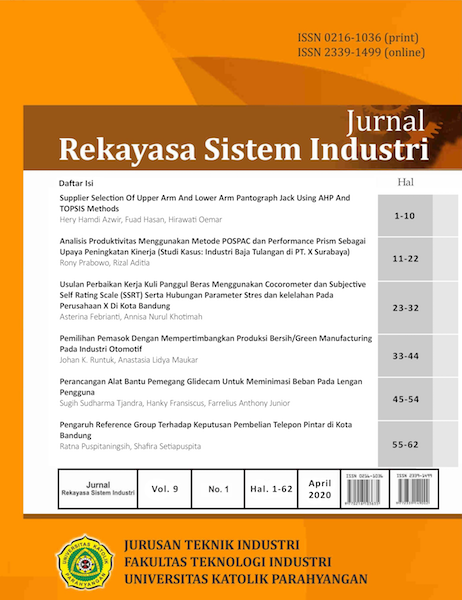Analisis Produktivitas Menggunakan Metode POSPAC dan Performance Prism Sebagai Upaya Peningkatan Kinerja (Studi Kasus: Industri Baja Tulangan di PT. X Surabaya)
DOI:
https://doi.org/10.26593/jrsi.v9i1.3362.11-22Abstract
This study aims to identify the partial productivity index and performance measurement in order to make efforts to increase the productivity of the production section at PT. X Surayaba which produces reinforcing steel using a rolling mill with POSPAC method and Performance Prism. Through productivity measurement POSPAC method obtained fluctuating results every month in each indicator the highest productivity ratio in the labor indicator in the July period with a productivity ratio of 76.96 and a productivity index of 123%, for the measurement of the lowest productivity in the product indicator the value of the productivity ratio of 0.61 and the productivity index of 87%. Through the Performance Prism method it is known that labor indicators need to be improved because based on KPI values only get a value of 29% due to low disciplinary factors and less effective at work.
Keywords: productivity, production, performance, prism, effective
References
Agustina, F. (2011). Analisis Produktivitas dengan Metode Objective Matrix (OMAX) di PT . X, 6(2), 150–158.
Neely, A., Adams, C., and Kennerley, M. (2012). The Performance Prism: The Scorecard for Measuring and Managing Business Success. United Kingdom: Copyright Licensing Agency Ktd.
Prabowo, R. (2017). Pengendalian Persediaan Bahan Baku Oli Untuk Mesin Diesel Tipe G4J-801, G5J-801 dan G7J-801 di PT. Hansan Asembling–Malang. PROZIMA (Productivity, Optimization and Manufacturing System Engineering), 1(1), 33-43.
Prabowo, R. (2016). Penerapan Konsep Line Balancing Untuk Mencapai Efisiensi Kerja yang Optimal pada Setiap Stasiun Kerja pada PT. HM. Sampoerna Tbk. Jurnal IPTEK, 20(2), 9-20.
Purnomo, C. A. & Hadi, Y. (2017). Pengukuran Kinerja Menggunakan Performance Prism. Malang; Jurnal Teknik Industri Universitas Ma Chung Malang.
Ramadhani, Y. (2011). Analisis efisiensi, skala dan elastisitas produksi dengan pendekatan cobb-douglas dan regresi berganda. Jurnal Teknologi 4(1): 53-61
Supriyanto, F. J., Yusuf, Y., & Wisnubroto. (2014). Analisis Produktivitas menggunakan Metode Cobb Douglas dan Metode Habberstad (POSPAC). Yogyakarta: Jurnal Teknik Industri AKPRIND
Suryanto, K.W. (2014). Tingkat Produktivitas Total dan Parsial PT. United Tractors Menggunakan Model Davis J. Sumanth dan Habberstad (POSPAC) yang Disesuaikan, Jurnal Teknik Industri ITB, Bandung.
Syarifuddin & Yani L. (2014). Analisis Produktivitas Perusahaan pada UD. Karya Jaya. Aceh: Jurnal Jurusan Teknik Industri Universitas Mallikus Saleh
Syarifuddin, Syukriah, & Jen R. M. (2017). Analisis Produktivitas Perusahaan Dengan Menggunakan Metode POSPAC di PT. Supra Matra Abadi. Aceh: Jurnal Teknik Industri Universitas Malikus Saleh
Wibowo, S. A (2018) Usulan Peningkatan Produktivitas menggunakan Lean Manufacturing Dengan VSM. Yogyakarta: Jurnal Teknik Industri Universitas Islam Indonesia
Widodo, E., Takahashi, K., Morikawa, K., Pujawan, I. N., & Santosa, B. (2009, December). Managing sales return in dual sales channel: An analysis of its product substitution. In Proceeding of Asia Pacific Industrial Engineering and Management System Conference (pp. 823-835).

